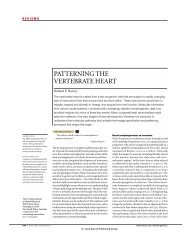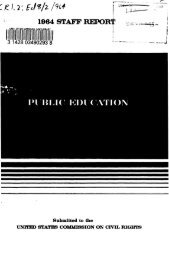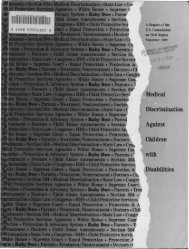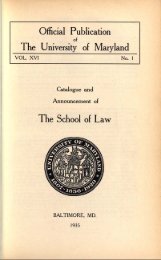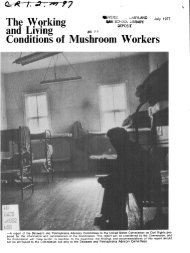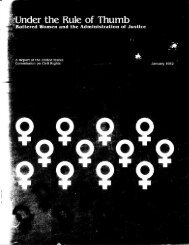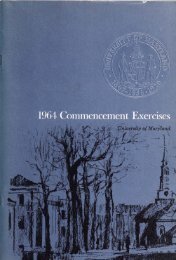1961 US Commission on Civil Rights Report Book 2 - University of ...
1961 US Commission on Civil Rights Report Book 2 - University of ...
1961 US Commission on Civil Rights Report Book 2 - University of ...
You also want an ePaper? Increase the reach of your titles
YUMPU automatically turns print PDFs into web optimized ePapers that Google loves.
INFERIORITY OF THE SCHOOL<br />
From 1896 until 1954 the requirements <strong>of</strong> the i4th amendment were<br />
met, if the separate schools for Negroes were equal to the separate schools<br />
for whites. 64 The School Segregati<strong>on</strong> Cases did not change this basic<br />
rule; they merely dispensed with the necessity <strong>of</strong> proving inequality in<br />
cases where racial segregati<strong>on</strong> is imposed by State acti<strong>on</strong>—for the<br />
Supreme Court held that as a matter <strong>of</strong> law "separate educati<strong>on</strong>al facilities<br />
are inherently unequal." Pro<strong>of</strong> <strong>of</strong> inequality <strong>of</strong> segregated schools<br />
therefore has not been a crucial element in the post-1954 cases arising<br />
in the South.<br />
In short, substantially equal governmental treatment <strong>of</strong> all pers<strong>on</strong>s<br />
regardless <strong>of</strong> their race, religi<strong>on</strong>, or nati<strong>on</strong>al origin was, and still is, the<br />
heart <strong>of</strong> the law. But suppose there is no State-promoted racial discriminati<strong>on</strong>—no<br />
improper gerrymandering, manipulati<strong>on</strong> <strong>of</strong> transfers, or<br />
site selecti<strong>on</strong>. Does mere inferiority <strong>of</strong> a particular school in c<strong>on</strong>trast to<br />
other schools in the same system c<strong>on</strong>stitute a denial <strong>of</strong> equal protecti<strong>on</strong>?<br />
Is a pupil denied equal protecti<strong>on</strong> when the particular school to which<br />
he is assigned is more crowded, has more pupils per teacher, less qualified<br />
teachers, or a more limited curriculum than other schools in the system?<br />
Overcrowding <strong>of</strong> some schools and empty or partially filled classrooms<br />
in others raises the questi<strong>on</strong> <strong>of</strong> when, if ever, is there a c<strong>on</strong>stituti<strong>on</strong>al duty<br />
to rez<strong>on</strong>e, or take other acti<strong>on</strong>, to secure a more even distributi<strong>on</strong> <strong>of</strong><br />
pupils. When does inacti<strong>on</strong> <strong>on</strong> the part <strong>of</strong> a school board become<br />
culpable n<strong>on</strong>feasance? Such questi<strong>on</strong>s, difficult enough in themselves,<br />
are <strong>of</strong>ten complicated by incompleted building programs and the undesirability<br />
<strong>of</strong> frequent transfers.<br />
In the Skipwith case, 68 decided by a domestic relati<strong>on</strong>s court <strong>of</strong> New<br />
York City in 1958, parents <strong>of</strong> Negro children were prosecuted under<br />
the compulsory school attendance law <strong>of</strong> New York for failure to send<br />
their children to school. Their defense was that the segregated public<br />
school to which their children were assigned was inferior to the predominantly<br />
white schools in the city; that they were refused the right<br />
to attend any other school; and that, therefore, they were denied equal<br />
protecti<strong>on</strong>. The court upheld the defense, and made it clear that the<br />
decisi<strong>on</strong> was not based up<strong>on</strong> a finding that racial segregati<strong>on</strong> in the<br />
schools was created by any misc<strong>on</strong>duct <strong>of</strong> the school authorities. 66<br />
. . . the c<strong>on</strong>clusi<strong>on</strong> must be drawn that de facto racial segregati<strong>on</strong><br />
exists in the Junior High Schools <strong>of</strong> New York City. . . . What<br />
the record in this case does not show is to what extent, if any, such<br />
segregati<strong>on</strong> is the c<strong>on</strong>sequence <strong>of</strong> circumstances other than residential<br />
segregati<strong>on</strong> not attributable to any governmental acti<strong>on</strong>.<br />
There is no evidence before the court that the racial compositi<strong>on</strong> <strong>of</strong><br />
in




